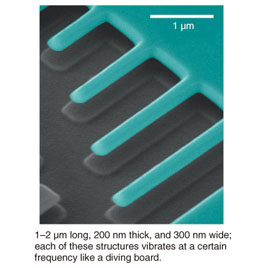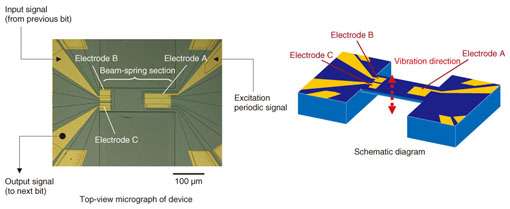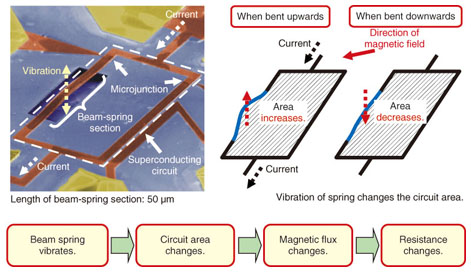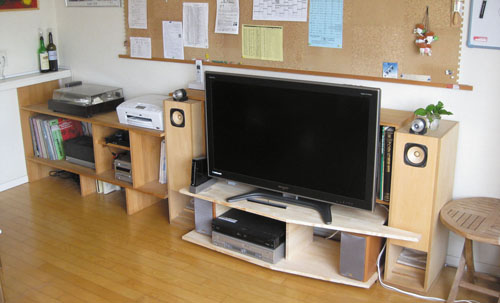 |
|
|
|
|
|
Front-line Researchers Vol. 9, No. 10, pp. 5–10, Oct. 2011. https://doi.org/10.53829/ntr201110fr1 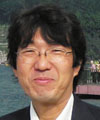 Take a Global View of Your Research and Put Your Ideas to WorkWe asked Dr. Hiroshi Yamaguchi, Senior Distinguished Researcher, to tell us about his research on nanomachine technology, which is attracting increasing attention in the world, from how he first conceived of pursuing nanomachines to the current state of his progress. We also asked him how his ten years of research in this field have influenced his outlook as a researcher, how he expresses his individuality as a researcher, and what advice he would give to young researchers. Globally acclaimed nanomachine technology—Dr. Yamaguchi, could you tell us about your research in terms that a person with no knowledge of semiconductors can understand? Sure. Let me give you a straightforward explanation using things we are all familiar with. To begin with, what do you think of upon hearing the word machine? No doubt many people think of a complicated piece of equipment made up of all kinds of components like gears and springs. This might be Astro Boy, the famous android character, or a locomotive that moves with a huge grinding sound generated by its internal gears and springs. The preconception that a machine uses a large amount of energy is also very common. Nowadays, however, making things small is becoming a dominant way of thinking in various research fields, and the same holds for machines. This field of technology is called micromachines or micro electromechanical systems. A projector for a personal computer, for example, can be equipped with an array of mirrors each smaller than an insect's foot. If such a micromirror is irradiated with light, the direction of reflection can be adjusted by fine mirror movement. When this is applied across the entire array, it enables the three primary colors (red, green, and blue, or RGB) to be synthesized on a screen and an image or video to be displayed. In short, micromachines are working away continuously like clockwork inside the projector, which represents one example of how micromachine technology can be applied in practice. Another example in common use can be found in car automobile airbags. The deployment mechanism includes a microscopic device less than 1 mm in size that vibrates at the time of a collision and a means for detecting that vibration electrically. Research and development on applying micromachine technology to such switch and sensor functions is progressing. We are taking up the challenge of developing new techniques for making micromachines as small as possible. Our ultimate goal is to achieve micromachines on the nanotechnology level, or in other words, nanomachines (Fig. 1).
—What kind of research activities are you coordinating to create such small machines? Well, this is all fundamental research, so we are at the stage of searching out what can be done and proposing what might be possible. There are two main research flows here. In the first one, our aim is to achieve a nanomachine computer that extends the function of the switch to information processing. Right now, we are just looking for the right way to go about this, but if we can come up with a completely novel idea to make calculations by a nanotechnology-based machine, it just might be possible to create a very-low-power computer. Such a nanomachine need not be limited to computers—it might also be possible to apply it to memory devices and components used for processing digital information. The key words here are low power. In the second research flow, we are pursuing the role of the micromachine as a sensor. We are researching ways of improving the sensitivity of existing accelerometers by several orders of magnitude, and our ultimate goal is to be able to detect contact with even one atom! Our theme here is "How small a force or object can we detect?" In this role, there is much anticipation from many fields for applying micromachines to biotechnology, DNA (deoxyribonucleic acid) detection, and medical laboratory equipment, as well as to the pursuit of limits in physics and the search for minimum units in physical movement and forces. —So your research is exploring unknown worlds. How far will these research efforts progress? There are various viewpoints on how far our research can go, so I can't really say in just a few words, but I can tell you about some results that we recently announced as examples of the progress we've been making. In April 2008, we proposed a nanomachine computer using a new principle for performing digital operations by using the minute vibration of a beam spring (Fig. 2). The heart of this device is the beam spring, which is thinner than the diameter of a human hair. In this device, a period offset occurs when the beam spring vibrates with an extremely small amplitude equivalent to only a few tens of atomic diameters (about 10 nm). By making such offsets correspond to '0' and '1' bits of information, we successfully performed 1-bit basic operations using a nanomachine. Achieving computation in this way using the extremely small vibrations of a beam spring suggests the possibility of a very-low-power device.
Moreover, in September of the same year, as joint research with Delft University of Technology in the Netherlands, we fabricated part of a superconducting quantum interference device (SQUID) as a nanomachine structure (beam spring) and successfully detected minute vibrations on the order of one ten-thousandth the size of an atom, which is about ten femtometers (10 fm) (Fig. 3). Observing quantum phenomena in a macroscopic object is a difficult challenge, but this new technique might make it possible in future. Although it has frequently been confirmed experimentally that the behavior of atoms—the constituent elements of all matter—is governed by quantum mechanics, which describes the basic laws of the microworld, experimentally investigating how macroscopic objects in the real world behave in quantum terms is expected to become a major research theme in the years to come. In short, we fabricated a vibration sensor with extremely high sensitivity for use in research of this type and successfully detected vibration on the order of one ten-thousandth the size of an atom.
More recently, we announced platform technology that shows promise for increasing the degree of integration in nanomachine computers. This technology is the first in the world to offer the possibility of configuring a logic circuit with only one basic device through the development of a digital operation technique that can execute multiple logic operations simultaneously. Up to now, multiple transistors have been necessary for even the most basic of logic operations, but with this new technique, we have successfully executed multiple logic operations with just one device. These technologies are not ready to be used in the development of actual equipment, but we will be testing the feasibility of applying them to practical devices in future research. —When did you begin this research? I began this research on nanomachines in 2000. Actually, I had been studying fundamental semiconductor properties up until 1998, but in this year I was transferred to the Planning Department of NTT Laboratories for a two-year stint. As a result, my work shifted from research to management. Upon completing this assignment, I found that I would be far behind other researchers if I were to continue with the same line of research after a two-year hiatus, so I thought, "Why not try something new, something that no one has worked on yet?" As a researcher, this two-year period of management duties prevented me from performing any experiments, but that did not mean that I took a break from research activities. Looking back, it was a great opportunity for making a big change in the way I looked at research. I learned of new research trends and was able to exercise originality and express my own ideas without imitating anyone. During my student days, I enjoyed the work of Shinichiro Tomonaga, the renowned theoretical physicist, and I read many books by him and about him and his work. Many wise quotes have been attributed to him, and among these, I cannot forget this one: "If there is a principle that I ascribe to, it's to not do what other people do." Being a follower may be comfortable, but doing things differently from others has shaped my stance on research in no small way. I also felt that, as one gains experience, the overall direction of the research that you are engaged in comes into view. I thought that by obtaining a firm understanding of the principle roles of your research —by taking a global overview instead of focusing on the fine details—and then applying your own original ideas, you could give birth to incredibly novel technology. There were just two or three groups around the world that had begun research on nanomachines at that time, and I kept a close eye on their progress. And it occurred to me that combining the semiconductor technology that I had researched for many years with nanomachine technology could very well help me create some very interesting devices. Now, after ten years of researching nanomachines, I feel that things are finally taking shape. A ten-year journey of experiencing growing pains but delivering world-first technologies—Was it smooth going during these last ten years? It was very hard at the beginning! I think that my research style is based more on the new ideas that come into my mind than on continuous and steady effort. I like new things, and I'm not satisfied unless I can move quickly on a new idea. But upon moving to the Planning Department in 1998, it suddenly dawned on me that the work of management would keep me busy and that I would not be able to research my ideas any day soon. So, while keeping abreast of nanomachine trends, I used to do some thinking on my days off or before going to bed. In this way, I gradually accumulated ideas. Then, when I returned to research in 2000, I found that those two or three groups elsewhere in the world researching nanomachines had already been announcing amazing results one after another. Of course, I had just started, and because of this late start, I wanted to do something different instead of just following the pack. But it's not that simple to get immediate results from something new and different. I was trying to produce results in an environment in which the people around me really couldn't help me, so perhaps it's natural that the early days of my research here were difficult. In fact, I began this research on my own, and I could not achieve even vibration measurement, which other researchers were doing on a routine basis. Being able to detect vibration would be the first step toward creating a device like a sensor, but I still could not do anything that would constitute this first step. So I got a real taste of growing pains here. —How can vibrations be detected? The resistance of a vibrating semiconductor changes as a result of bending, and the task is to read that change from the outside. However, this change in resistance appears as an extremely small change in current on the order of one millionth of the applied current. In retrospect, reading such a small change in current is not so difficult, but at the time, the know-how to do so was simply non-existent, so I had no choice but to fabricate structures and devise characterization methods on my own from scratch. It was around this time that an intern from France was assigned to me to work as my assistant. One of his duties was to carry out experiments under my supervision. When an experiment was going well, my task of supervising him went well too, but when no progress was being made, he would have no material to report on, so I found myself worrying not only about myself but also about my assistant. This was a difficult environment to be in. To be honest, this period at the beginning of these ten years of research was the most trying. But then, on Christmas night in 2000, we were working late, and we detected minute vibrations for the very first time, which means that we had successfully completed the first stage of our research. What a wonderful Christmas present that was! And I remember well how happy this made my French assistant. Somehow, our research continued to progress. In 2004, a paper that my colleagues and I wrote was accepted by the prestigious journal Physical Review Letters of the American Physical Society and it received enthusiastic praise from readers. Then, in 2007, my colleagues and I developed an original device called a parametric resonator. I was honored that this technology received much praise from outside NTT, and it made me feel that our research was finally taking off. —In such a difficult environment, you might have given up. How were you able to persevere? Perhaps it was because I had already left one research area before. When starting a completely new line of research, it feels as if the ladder has been pulled away from underneath you leaving you stranded. I think that making up my mind to go forward at any cost had a big impact on how I dealt with this situation. Furthermore, while my experiments did not go as planned in the beginning, doing them over and over again eventually produced not only results that I had hoped to find but also very interesting ones that I had not expected at all. A feeling of "I can do this!" suddenly came upon me. It is essential to continue with research even if results are not immediately forthcoming. And when I say continue, I also mean exploring new possibilities. In other words, I think that a researcher should strive for a good balance between a stubborn attitude that continues with one approach and an adventurous attitude of not being afraid to try new things. Experiencing the true pleasure of monozukuri—Other than research, do you have other interests that take up your time? Yes, I do. Since childhood, I have enjoyed making things, which in Japanese we call monozukuri. I began assembling radios as a kid, and since then, I've assembled or made a variety of things, like stereo amplifiers, speakers, racks, desks, and small balcony ponds. My current work leaves me with little time for this pursuit, but I have recently built some bookshelves for my daughter's desk and a stand for my large-screen television (Photo 1). The true pleasure of making things yourself comes from possessing a unique item that exists nowhere else in the world and creating something that completely matches your personal needs. I love the feeling of looking for the best way to make something and finally completing it, which tells me something about the research process. For example, techniques for producing good sound from speakers and methods for amplifying small electrical signals in a stereo amplifier with low noise are very similar in concept to what I use in generating vibration in the nanomechanical devices that I'm currently working on and amplifying those signals. In this sense, the ability to work at something related to things that I first learned about through childhood hobbies gives me great satisfaction.
In addition, since I'm not so young anymore, I'm concerned about maintaining my health, and though I'm not a sports enthusiast, I jog several kilometers on the weekends and sometimes walk to work from the train station, instead of catching the bus, which takes me about fifty minutes. This exercise helps improve my blood circulation and make me feel better all around. —Dr. Yamaguchi, would you leave us with some words of encouragement for young researchers? I would love to. First, it's vitally important for a researcher to express his or her originality, and this, of course, applies to me too. I think that young researchers, especially talented and ambitious ones, want to experience great results early on and to perform work that they have devised themselves. But I would ask them to develop their originality in research carefully without rushing things along. Instead of going all out for an early home run, I believe that focusing diligently on the work that has been assigned to you and then expressing your originality as an extension of that work will be more effective in putting you on the path to success. At first, this might take some time, but in years to come, there will be more than enough opportunities for you to demonstrate the knowledge and know-how that you have accumulated. I think that many young researchers are ill at ease with the work that has been assigned to them since it differs from the main field of their university studies and is not what they feel they are good at. I can empathize with this, as I was very impatient when I entered NTT Laboratories. But in truth, I think that a good approach is to figure out how to make the best of work that has been assigned to you regardless of your past studies and to supplement that work with your original ideas and methods. You may experience great difficulties in the beginning, but once your hard work begins to bear fruit, you should be able to look back at the road you have taken with a whole new perspective. So, to all young researchers, I wish you great success in your endeavors. Hiroshi YamaguchiSenior Distinguished Researcher, Executive Manager of the Physical Science Laboratory and Group Leader of the Nanostructure Technology Research Group, NTT Basic Research Laboratories. He received the B.E. and M.S. degrees in physics and the Ph.D. degree in engineering from Osaka University in 1984, 1986, and 1993, respectively. He joined NTT Basic Research Labora-tories in 1986. His current interests are micro/nanomechanical devices using semiconductor heterostructures. He has been a guest professor at Tohoku University since 2006. He is an IOP Fellow and a member of the Japan Society of Applied Physics, the Physical Society of Japan, and IEEE. |
|








